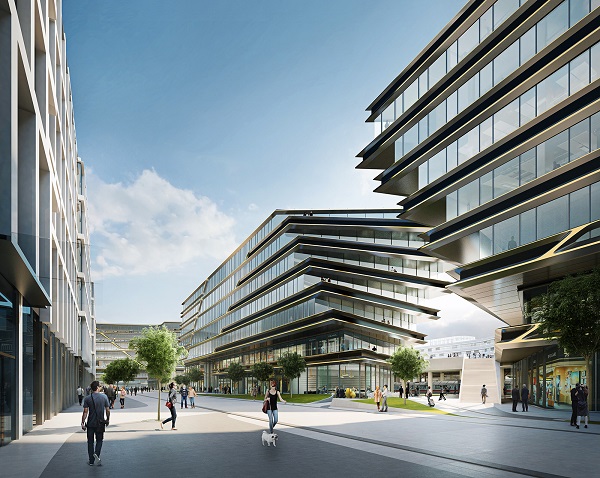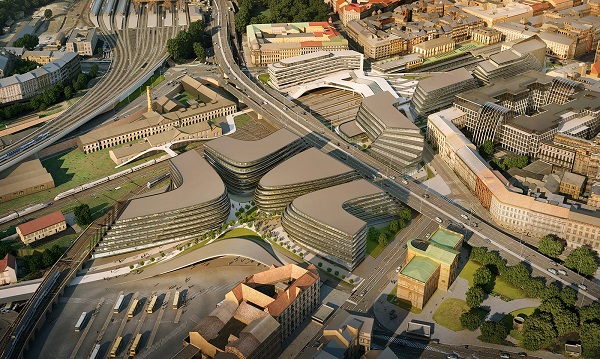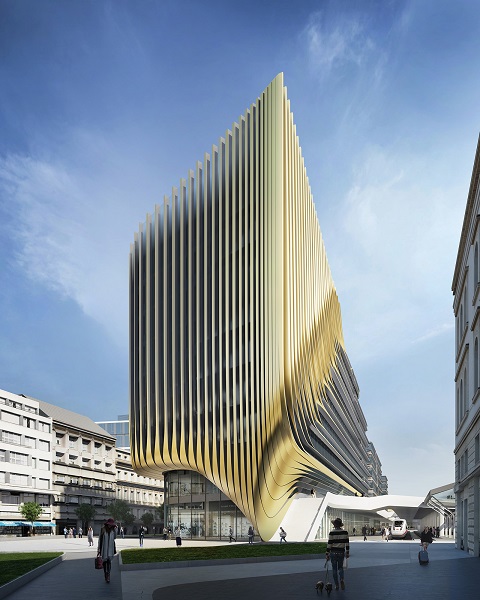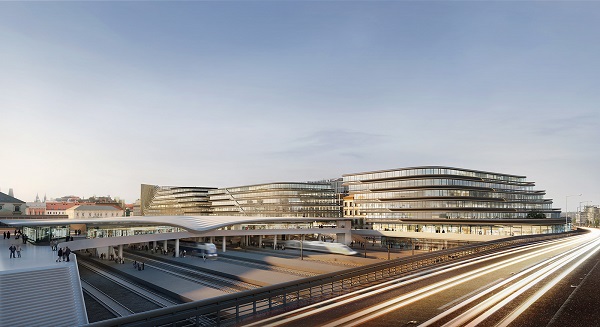Masaryk Railway Station regeneration
In May 2016, Zaha Hadid Architects (ZHA) revealed their plans with local partners and the city of Prague for the regeneration of a brownfield urban site adjacent to the city's Masaryk Railway Station. Having stood derelict for several decades, the aim of the project is to return the site to active use.
The mixed-use development stitches together Prague's Districts 1, 3 and 8, minimising the impact of the elevated Wilsonova Highway which separates them. Around 1 km from Prague's central square, the project creates a sequence of buildings and interconnecting public spaces along Na Florenci Boulevard, as well as a new public plaza adjacent to the railway station.
It is anticipated that over 22,000 sq. m of disused land adjacent to Masaryk Railway Station will be regenerated into a new central business district for the city, with the construction of approximately 90,000 sq. m of mixed-use office, retail and public spaces.
The design responds to the Old Town's urbanism. known as 'the city of 100 spires'; establishing a dialogue with the city and anchoring the new public plaza at the station by dynamically transforming the project's horizontal composition parallel with the railway lines to the vertical on the west façade facing the Old Town.
Designed as a series of buildings that vary in scale and composition to be compatible with the city's existing urban fabric, the new central business district responds to the demands of the city's growing service and IT sector requirements for flexible Class A office accommodation.
Construction of phase one could be completed in 2020, with all phases completed in 2022. Penta, the majority owner of the development consortium, will spend CZK 135 million on the reconstruction of Masaryk Railway Station, with a total budget for regenerating the site exceeding CZK 6.5 billion.
Marek Dospiva, Partner at Penta, said:
“Since selecting Zaha Hadid Architects' design as the winner of the 2014 competition, Penta has partnered with the city, Zaha Hadid and her team at ZHA to develop the designs to regenerate this site in the capital that has been abandoned for decades into a vibrant new central business district with exceptional public spaces.”
Craig Kiner, Project Associate at ZHA said:
“In collaboration with our partners and the city, we have developed an urbanism for the site which draws inspiration from our analysis of the city and the site's dynamic circulation networks, creating an architectural response that is sensitive to context, unifying in aspiration and contributes to the urban fabric of Prague.”
Content and images courtesy of Zaha Hadid Architects.
[edit] Related articles on Designing Buildings Wiki
- 600 Collins Street, Melbourne.
- Battersea power station.
- Brownfield land.
- D'Leedon, Singapore.
- England's Railway Heritage from the Air.
- Enterprise zones.
- Housing contribution to regeneration.
- Kaohsiung Station, Taiwan.
- Millennium Mills.
- Port House, Antwerp.
- Salerno Maritime Terminal.
- Railway stations.
- Regeneration.
- Vienna Central Station.
- Wembley Park.
- Zaha Hadid.
Featured articles and news
Latest Build UK Building Safety Regime explainer published
Key elements in one short, now updated document.
UKGBC launch the UK Climate Resilience Roadmap
First guidance of its kind on direct climate impacts for the built environment and how it can adapt.
CLC Health, Safety and Wellbeing Strategy 2025
Launched by the Minister for Industry to look at fatalities on site, improving mental health and other issues.
One of the most impressive Victorian architects. Book review.
Common Assessment Standard now with building safety
New CAS update now includes mandatory building safety questions.
RTPI leader to become new CIOB Chief Executive Officer
Dr Victoria Hills MRTPI, FICE to take over after Caroline Gumble’s departure.
Social and affordable housing, a long term plan for delivery
The “Delivering a Decade of Renewal for Social and Affordable Housing” strategy sets out future path.
A change to adoptive architecture
Effects of global weather warming on architectural detailing, material choice and human interaction.
The proposed publicly owned and backed subsidiary of Homes England, to facilitate new homes.
How big is the problem and what can we do to mitigate the effects?
Overheating guidance and tools for building designers
A number of cool guides to help with the heat.
The UK's Modern Industrial Strategy: A 10 year plan
Previous consultation criticism, current key elements and general support with some persisting reservations.
Building Safety Regulator reforms
New roles, new staff and a new fast track service pave the way for a single construction regulator.
Architectural Technologist CPDs and Communications
CIAT CPD… and how you can do it!
Cooling centres and cool spaces
Managing extreme heat in cities by directing the public to places for heat stress relief and water sources.
Winter gardens: A brief history and warm variations
Extending the season with glass in different forms and terms.
Restoring Great Yarmouth's Winter Gardens
Transforming one of the least sustainable constructions imaginable.


























